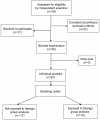Sensory functions in the foot soles in victims of generalized torture, in victims also beaten under the feet (falanga) and in healthy controls - A blinded study using quantitative sensory testing
- PMID: 23272808
- PMCID: PMC3553028
- DOI: 10.1186/1472-698X-12-39
Sensory functions in the foot soles in victims of generalized torture, in victims also beaten under the feet (falanga) and in healthy controls - A blinded study using quantitative sensory testing
Abstract
Background: Falanga torture (beatings on the foot soles) produces local chronic pain and severe walking difficulties. We have previously reported signs of neuropathic pain in the feet of falanga victims. The objective here was to clarify underlying pain mechanisms by quantifying sensory impairments in the feet of torture victims who had experienced both generalized torture and those who had been exposed to falanga in addition. An ethnically matched control group was available.
Methods: We employed quantitative sensory testing (QST) by investigators blinded to whether the patients, 32 male torture victims from the Middle East, had (n=15), or had not (n=17) been exposed to falanga. Pain intensity, area and stimulus dependence were used to characterize the pain as were interview data on sensory symptoms. QST included thresholds for touch, cold, warmth, cold-pain, heat-pain, deep pressure pain and wind-up to cutaneous noxious stimuli in the foot soles. Clinical data on anxiety and depression were retrieved.
Results: Almost all falanga victims had moderate or strong pain in their feet and in twice as large an area of their foot soles as other torture victims. One-third of the latter had no pain in their feet and many reported slight pain; in spite of this, there were no differences in foot sole QST data between the tortured groups. A comparison with normal data indicated that both tortured groups had hypoesthesia for all cutaneous sensory fibre groups except those transmitting cold and heat pain, in addition to deep mechano-nociceptive hyperalgesia.
Conclusion: A comparison of the QST data between victims having been exposed to generalized torture and victims who in addition had been exposed to falanga, showed no differences on the group level. The sensory disturbances in relation to our control group are compatible with central sensitization and de-sensitization, pointing to a core role of central mechanisms. A further analysis to create individual sensory profiles from our measurements is in progress.
Figures
Similar articles
-
Pain when walking: individual sensory profiles in the foot soles of torture victims - a controlled study using quantitative sensory testing.BMC Int Health Hum Rights. 2012 Dec 31;12:40. doi: 10.1186/1472-698X-12-40. BMC Int Health Hum Rights. 2012. PMID: 23276199 Free PMC article.
-
Clinical findings in men with chronic pain after falanga torture.Clin J Pain. 2008 Feb;24(2):135-41. doi: 10.1097/AJP.0b013e31815aac36. Clin J Pain. 2008. PMID: 18209520
-
Foot Torture (Falanga): Ten Victims with Chronic Plantar Hyperpigmentation.Am J Med. 2021 Feb;134(2):278-281. doi: 10.1016/j.amjmed.2020.08.016. Epub 2020 Sep 15. Am J Med. 2021. PMID: 32941848
-
Long-term consequences of falanga torture--what do we know and what do we need to know?Torture. 2009;19(1):33-40. Torture. 2009. PMID: 19491485 Review.
-
Neuropathic pain: is quantitative sensory testing helpful?Curr Diab Rep. 2012 Aug;12(4):393-402. doi: 10.1007/s11892-012-0282-7. Curr Diab Rep. 2012. PMID: 22623149 Review.
Cited by
-
Pain when walking: individual sensory profiles in the foot soles of torture victims - a controlled study using quantitative sensory testing.BMC Int Health Hum Rights. 2012 Dec 31;12:40. doi: 10.1186/1472-698X-12-40. BMC Int Health Hum Rights. 2012. PMID: 23276199 Free PMC article.
-
Pain from torture: assessment and management.Pain Rep. 2019 Oct 28;4(6):e794. doi: 10.1097/PR9.0000000000000794. eCollection 2019 Nov-Dec. Pain Rep. 2019. PMID: 31984299 Free PMC article.
-
Reported Methods, Distributions, and Frequencies of Torture Globally: A Systematic Review and Meta-Analysis.JAMA Netw Open. 2023 Oct 2;6(10):e2336629. doi: 10.1001/jamanetworkopen.2023.36629. JAMA Netw Open. 2023. PMID: 37787994 Free PMC article.
References
-
- Rasmussen OV. Medical aspects of torture. Dan Med Bull. 1990;37(Suppl 1):1–88. - PubMed
-
- Rejali D. Torture and Democracy. Princeton University Press, Oxford; 2007. Sticks and bones; pp. 273–277.
LinkOut - more resources
Full Text Sources


